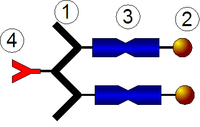
Photo from wikipedia
Supramolecular protein hydrogels with tunable properties represent promising candidates for advanced designer extracellular matrices (ECMs). To control cellular functions, ECMs should be able to spatiotemporally regulate synergistic signaling between transmembrane… Click to show full abstract
Supramolecular protein hydrogels with tunable properties represent promising candidates for advanced designer extracellular matrices (ECMs). To control cellular functions, ECMs should be able to spatiotemporally regulate synergistic signaling between transmembrane receptors and growth factor (GF) receptors. In this study, we developed genetically engineered temperature-responsive multifunctional protein hydrogels. The designed hydrogel was fabricated by combining the following four peptide blocks: thermosensitive elastin-like polypeptides (ELPs), a polyaspartic acid (polyD) chain to control aggregation and delivery of GFs, a de novo-designed helix peptide that forms antiparallel homotetrameric coiled-coils, and a biofunctional peptide. The resultant coiled-coil unit bound ELPs (CUBEs) exhibit a controllable sol-gel transition with tunable mechanical properties. CUBEs were functionalized with bone sialoprotein-derived RGD (bRGD), and human umbilical vein endothelial cells (HUVECs) were three-dimensionally cultured in bRGD-modified CUBE (bRGD-CUBE) hydrogels. Proangiogenic activity of HUVECs was promoted by bRGD. Moreover, heparin-binding angiogenic GFs were immobilized to bRGD-CUBEs via electrostatic interactions. HUVECs cultured in GF-tethered bRGD-CUBE hydrogels formed three-dimensional (3-D) tubulelike structures. The designed CUBE hydrogels may demonstrate utility as advanced smart biomaterials for biomedical applications. Further, the protein hydrogel design strategy may provide a novel platform for constructing designer 3-D microenvironments for specific cell types.
Journal Title: Biomacromolecules
Year Published: 2020
Link to full text (if available)
Share on Social Media: Sign Up to like & get
recommendations!